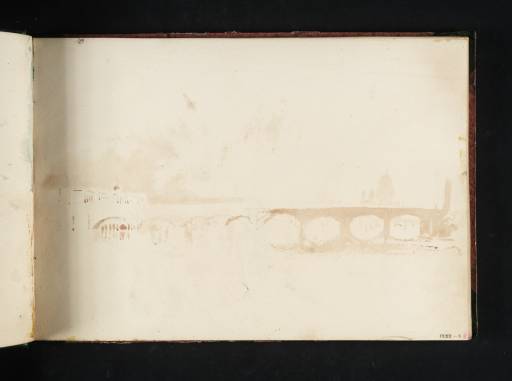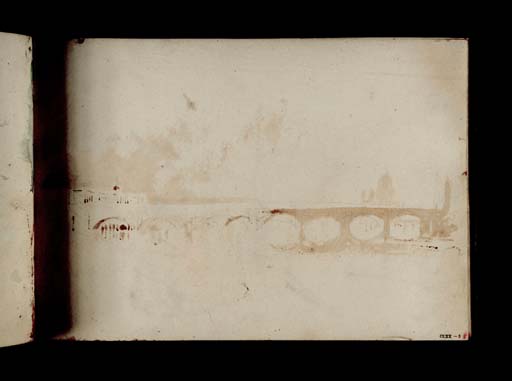Joseph Mallord William Turner London: Waterloo Bridge, with Somerset House and St Paul's Cathedral in the Distance c.1820
Image 1 of 2
Joseph Mallord William Turner,
London: Waterloo Bridge, with Somerset House and St Paul's Cathedral in the Distance
c.1820
Joseph Mallord William Turner 1775–1851
Folio 6 Recto:
London: Waterloo Bridge, with Somerset House and St Paul’s Cathedral in the Distance circa 1820
D13820
Turner Bequest CLXX 5
Turner Bequest CLXX 5
Pencil and watercolour on off-white wove paper, 177 x 256 mm
Inscribed in red ink by John Ruskin ‘5’ bottom right
Stamped in black ‘CLXX – 5’ bottom right
Inscribed in red ink by John Ruskin ‘5’ bottom right
Stamped in black ‘CLXX – 5’ bottom right
Accepted by the nation as part of the Turner Bequest 1856
References
1909
A.J. Finberg, A Complete Inventory of the Drawings of the Turner Bequest, London 1909, vol.I, p.493, CLXX 5, as ‘Bridge, with church in distance. Sepia.’.
1974
Martin Butlin, Andrew Wilton and John Gage, Turner 1775–1851, exhibition catalogue, Royal Academy, London 1974, p.85 under cat.203.
Folios 6–10 (D13820–D13824; CLXX 5–9) have been linked by Andrew Wilton to two sketches in the Tabley Sketchbook, No.3 (Tate D07094, D07106; Turner Bequest CV 72, 78), the latter of which was identified by Finberg as depicting Waterloo Bridge in London.1 The bridge is identifiable in the current study by its proximity to Somerset House which lies behind it to the left, and St Paul’s Cathedral beyond it to the right. Its characteristic double Doric columns between each arch are seen clearly in folio 7. As Finberg noted in the introduction to the Tabley book, the sketches on the Thames ‘are probably about 1820.’2 Its recent opening (1817) may have been what inspired Turner to make these studies. He may also have been collecting subjects for an unrealised illustrated publication on London proposed by W.B. Cooke in the early 1820s.3
The five sketches, along with three studies near London Bridge in this sketchbook were executed in pencil and brown (or sepia) watercolour, and were probably made en plain air in front of the motif (folios 11, 12 and 43; D13826, D13827, D13858; CLXX 10, 11, 42; see also folios 13 and 14; D13828, D13829; CLXX 12, 13). This may explain why Turner used only one colour (the blue in folio 43 may have been added later), but another reason may be linked to the technique that Turner employed for designs for the Liber Studiorum and so-called Little Liber. Ian Warrell has linked monochrome studies in the Old London Bridge sketchbook (Tate D17834–D17912; D40961–D40965 complete sketchbook; Turner Bequest Finberg CCV) to Turner’s experiments with the technique of conveying a coloured effect in black and white and his ‘preoccupations behind the series of mezzotints known as the ‘Little Liber’.4 Turner also used brown washes in the Hesperides (1) sketchbook (Tate D05766–D05842; D05844; D40632; D40634–D40636 complete sketchbook; Turner Bequest XCIII), which contains related subjects to the Scotland and London book.
The current sketch was roughly planned out in pencil and then draw in more detail in brown watercolour wash. Turner did not follow his pencil lines exactly, moving the bridge arches slightly to the right. The bend of the river just beyond the bridge means that St Paul’s appears well to the right. It is seen through one of the arches of the bridge on folio 8 and again on folio 10.
Verso:
Blank
Thomas Ardill
August 2009
How to cite
Thomas Ardill, ‘London: Waterloo Bridge, with Somerset House and St Paul’s Cathedral in the Distance c.1820 by Joseph Mallord William Turner’, catalogue entry, August 2009, in David Blayney Brown (ed.), J.M.W. Turner: Sketchbooks, Drawings and Watercolours, Tate Research Publication, December 2012, https://www


